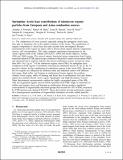Springtime Arctic haze contributions of submicron organic particles from European and Asian combustion sources
Author(s)
Kroll, Jesse; Frossard, Amanda A.; Shaw, Patrick M.; Russell, Lynn M.; Canagaratna, M. R.; Worsnop, Douglas R.; Quinn, Patricia K.; ... Show more Show less
DownloadKroll_Springtime arctic.pdf (1.245Mb)
PUBLISHER_POLICY
Publisher Policy
Article is made available in accordance with the publisher's policy and may be subject to US copyright law. Please refer to the publisher's site for terms of use.
Terms of use
Metadata
Show full item recordAbstract
The composition of Arctic aerosol, especially during the springtime Arctic haze, may play an important role in the radiative balance of the Arctic. The contribution of organic components to Arctic haze has only recently been investigated. Because measurements in this region are sparse, little is known about organic particle composition, sources, and concentrations. This study compares springtime measurements in the Arctic regions north of the Atlantic (ICEALOT, 2008) and Pacific (Barrow, Alaska, 2008 and 2009) oceans. The aerosol organic functional group composition from Fourier transform infrared (FTIR) spectroscopy combined with positive matrix factorization (PMF) and elemental tracer analysis indicate that mixed combustion sources account for more than 60% (>0.3 μg m−3) of the submicron organic mass (OM1) for springtime haze conditions in both regions. Correlations with typical combustion tracers (S, Zn, K, Br, V) provide evidence for the contribution of combustion sources to the Arctic OM1. However, the two regions are influenced by different urban and industrial centers with different fuel usage. High-sulfur coal burning in northeastern Europe impacts the northern Atlantic Arctic region, while oil burning and forest fires in northeastern Asia and Alaska impact the northern Pacific Arctic region. Quadrupole and High Resolution Aerosol Mass Spectrometry measurements confirm the highly oxygenated nature of the OM1, with an oxygenated organic aerosol (OOA) spectrum from PMF. High co-emissions of sulfate and organics from coal-burning in northeastern Europe produce significant concentrations of organosulfate functional groups that account for 10% of OM1 measured by FTIR spectroscopy during ICEALOT. These observations provide preliminary support for a heterogeneous mechanism of organosulfate formation on acidic sulfate particles.
Date issued
2011-03Department
Massachusetts Institute of Technology. Department of Civil and Environmental EngineeringJournal
Journal of Geophysical Research. Atmospheres
Publisher
American Geophysical Union (AGU)
Citation
Frossard, Amanda A. et al. “Springtime Arctic Haze Contributions of Submicron Organic Particles from European and Asian Combustion Sources.” Journal of Geophysical Research 116.D5 (2011). 2011 John Wiley & Sons, Inc.
Version: Final published version
ISSN
0148-0227
2156–2202